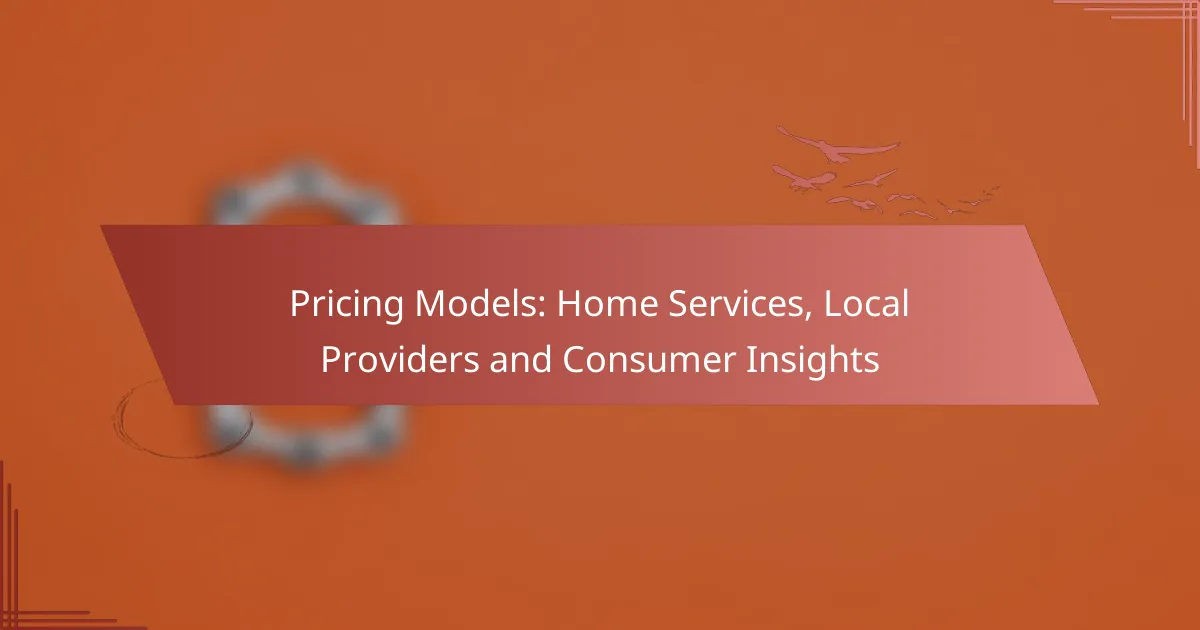Home services in New York employ a range of pricing models tailored to meet the diverse needs of consumers and the capabilities of local providers. Common approaches include hourly rates, flat fees, subscription services, and dynamic pricing based on demand. Local providers set their prices by evaluating market demand, material and labor costs, and the competitive landscape, ensuring they remain both attractive and profitable. Consumer perceptions of pricing are influenced by factors such as service quality, brand reputation, customer reviews, and promotional offers.

What are the pricing models for home services in New York?
Home services in New York typically utilize various pricing models that cater to consumer needs and service provider capabilities. The most common models include hourly rates, flat fees, subscription services, and variable pricing based on demand.
Hourly rates
Hourly rates are a straightforward pricing model where consumers pay for the actual time spent on the service. In New York, these rates can range from around $50 to $150 per hour, depending on the type of service and the provider’s expertise.
When opting for hourly rates, it’s essential to clarify what the rate includes, such as travel time or materials. Consumers should also consider the potential for longer service times, which can increase overall costs.
Flat fees
Flat fees offer a fixed price for specific services, providing consumers with predictable costs. For example, a plumbing service might charge a flat fee of $200 for a standard faucet installation.
This model is beneficial for straightforward tasks, as it eliminates uncertainty about the final bill. However, consumers should ensure that the scope of work is clearly defined to avoid additional charges for unforeseen issues.
Subscription services
Subscription services allow consumers to pay a recurring fee for ongoing home maintenance or services. This model can range from monthly to annual payments and often includes benefits like priority scheduling and discounted rates.
For instance, a home cleaning service might offer a subscription plan for $100 per month, covering bi-weekly cleanings. This model can be cost-effective for regular services but may not suit those who prefer occasional help.
Variable pricing based on demand
Variable pricing based on demand adjusts service costs according to market conditions, such as peak seasons or high-demand periods. In New York, this can mean higher rates during busy times, like holidays or summer months.
Consumers should be aware of these fluctuations and consider scheduling services during off-peak times to save money. It’s advisable to check with providers about their pricing policies to avoid surprises during peak demand periods.

How do local providers determine pricing?
Local providers determine pricing by considering various factors such as market demand, costs of materials and labor, and competitive landscape. These elements help them set prices that are both competitive and profitable.
Market research
Market research involves analyzing local demand for services and understanding customer preferences. Providers often survey potential customers or study trends in their area to gauge what consumers are willing to pay.
For instance, a plumbing service might find that homeowners in a specific neighborhood prioritize quick response times, allowing them to charge a premium for urgent services. Understanding these dynamics is crucial for setting effective pricing strategies.
Cost of materials
The cost of materials directly impacts pricing for home services. Providers must account for the expenses associated with the supplies needed to complete a job, which can vary widely based on quality and availability.
For example, a landscaping service may choose between high-quality soil or more affordable options, influencing their overall costs and, consequently, their pricing. Regularly reviewing supplier prices can help providers adjust their rates accordingly.
Labor costs
Labor costs are a significant component of pricing for local service providers. This includes wages, benefits, and any additional expenses related to hiring skilled workers. Providers need to ensure that their pricing covers these costs while remaining attractive to customers.
In many regions, labor rates can vary based on skill level and local market conditions. For instance, a skilled electrician may command higher rates than a general handyman, reflecting their specialized expertise.
Competition analysis
Competition analysis involves evaluating what similar local providers charge for comparable services. This helps businesses position themselves within the market and avoid pricing themselves out of potential jobs.
For example, if most local cleaning services charge around $100 for a standard home clean, a new provider may choose to set their price slightly lower to attract initial customers. However, they must balance competitive pricing with the need to cover costs and maintain quality service.

What factors influence consumer insights on pricing?
Consumer insights on pricing are shaped by various elements that affect perceived value and decision-making. Key factors include the quality of service, brand reputation, customer reviews, and available promotions or discounts.
Quality of service
The quality of service directly impacts consumer perceptions of pricing. High-quality services often justify higher prices, as customers associate them with better outcomes and satisfaction. For example, a plumbing service that guarantees prompt response times and effective solutions may charge more than competitors.
When evaluating service quality, consider factors such as expertise, reliability, and customer support. Consumers tend to favor providers who demonstrate professionalism and deliver consistent results, even if it means paying a premium.
Brand reputation
Brand reputation plays a crucial role in shaping consumer insights on pricing. Established brands with a positive reputation can often command higher prices due to consumer trust and loyalty. For instance, a well-known landscaping company may charge more than a lesser-known competitor simply because of its proven track record.
To build a strong brand reputation, providers should focus on delivering exceptional service, engaging with customers, and maintaining transparency. A solid reputation can lead to increased customer retention and willingness to pay higher prices.
Customer reviews
Customer reviews significantly influence consumer insights on pricing by providing social proof of service quality. Positive reviews can enhance perceived value, leading customers to feel more comfortable paying higher prices. Conversely, negative feedback can deter potential clients and lead to price sensitivity.
Encouraging satisfied customers to leave reviews on platforms like Google or Yelp can boost a provider’s credibility. It’s essential to monitor feedback and address any concerns promptly to maintain a favorable image and justify pricing strategies.
Promotions and discounts
Promotions and discounts can effectively influence consumer insights on pricing by creating a sense of urgency and perceived savings. Limited-time offers or seasonal discounts can attract price-sensitive customers who may otherwise hesitate to engage a service provider.
However, providers should use promotions strategically to avoid devaluing their services. Offering discounts on bundled services or first-time customer incentives can encourage trial without undermining long-term pricing strategies. Always ensure that promotions align with the overall brand image and service quality.

How do pricing models vary across different home services?
Pricing models for home services differ significantly based on the type of service, market demand, and local competition. Factors such as labor costs, materials, and service complexity influence how providers set their rates.
Cleaning services
Cleaning services typically charge either hourly rates or flat fees based on the size and condition of the space. Hourly rates can range from $25 to $75 per hour, while flat fees for standard homes might start around $100 and increase based on square footage and specific tasks.
When hiring cleaning services, consider the frequency of service needed. Regular cleanings often come with discounts, while one-time deep cleans may have higher rates. Always ask for a detailed quote to avoid surprises.
Plumbing services
Plumbing services often use a combination of flat rates for common tasks and hourly rates for more complex jobs. Basic repairs like unclogging a drain might cost between $100 and $200, while emergency services can escalate to $300 or more, depending on the time of day.
It’s crucial to check if the plumber charges for travel time or has a minimum service fee. Always request estimates before work begins, and inquire about warranties on parts and labor to ensure you’re covered for future issues.
Landscaping services
Landscaping services generally offer pricing based on project scope, which can include design, installation, and maintenance. Simple lawn care might cost around $50 to $150 per visit, while larger projects like garden installations can range from a few hundred to several thousand dollars.
When considering landscaping, clarify what services are included in the price. Seasonal contracts can provide savings for regular maintenance, but ensure you understand the terms and conditions before committing.
Electrical services
Electrical services often charge by the hour, with rates typically ranging from $70 to $150 per hour, depending on the complexity of the job and local market conditions. For specific tasks like installing fixtures or outlets, flat rates might apply, often starting around $100.
Before hiring an electrician, verify their licensing and insurance. It’s advisable to get multiple quotes for larger projects and to ask about potential additional costs, such as permits or materials, to ensure a clear understanding of the total expenses involved.

What are the benefits of subscription pricing for home services?
Subscription pricing for home services offers consumers predictable costs and fosters long-term relationships with service providers. This model allows customers to budget effectively while ensuring they receive consistent service, which can lead to enhanced satisfaction and loyalty.
Predictable costs
Subscription pricing creates predictable costs for consumers, eliminating the uncertainty of variable pricing associated with traditional service models. Customers pay a fixed fee, often monthly or annually, which helps in budgeting for home maintenance and repairs.
For example, a monthly subscription for lawn care might range from $50 to $150, depending on the services included. This predictability allows homeowners to plan their finances without unexpected expenses disrupting their budgets.
Enhanced customer loyalty
Subscription models can significantly enhance customer loyalty by establishing a consistent relationship between providers and consumers. When customers commit to a subscription, they are more likely to continue using the same service, as they perceive added value in the ongoing relationship.
Providers often reward loyal subscribers with perks, such as discounts on additional services or priority scheduling. This not only incentivizes customers to stay but also encourages them to refer friends and family, further solidifying the provider’s customer base.
